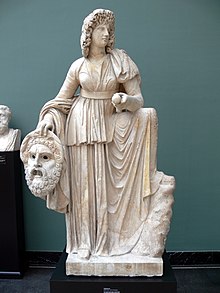Melpomene
| Melpomene | |
|---|---|
Goddess of Tragedy and Chorus | |
| Member of the Muses | |
 Roman statue of Melpomene, 2nd century AD. The muse is shown in a long-sleeved garment with a high belt, clothing that was associated with tragic actors. Her wreath of vines and grapes alludes to Dionysus, the god of the theatre | |
| Abode | Mount Olympus |
| Symbols | Tragic mask |
| Personal information | |
| Parents | Zeus and Mnemosyne |
| Siblings | Euterpe, Polyhymnia, Urania, Clio, Erato, Thalia, Terpsichore, Calliope and several paternal half-siblings |
| Consort | Achelous |
| Children | the Sirens |

In
Etymology
Melpomene's name is derived from the Greek verb melpô or melpomai meaning "to celebrate with dance and song".[1] The Oxford English Dictionary cites μέλπειν (melpein – to sing).[2]
Myth
Melpomene is one of the nine
Melpomene is described as singing songs of mourning for people of note after they die, particularly for poets.[6]
Iconography and depiction
Depictions of Melpomene may include a tragic mask,
The iconographer
Invocation and use
Literature
In Greek and Latin poetry since Horace (d. 8 BC), it was commonly auspicious to invoke Melpomene.[8] Horace invokes Melpomene in Ode 3.30, when he describes his poetry as a monument as great as any king's tomb. The poet asks Melpomene to crown him with a laurel wreath and make him a poet laureate.[9]
Visual art
The oldest surviving portrait of Virgil, a mosaic dated to the first century, features Virgil between Melpomene and Clio, the muse of history. Theologian Louis A. Ruprecht interpreted this as a commentary on the similarities of recording history and writing fictional works of tragedy.[10]
The 2018 excavation of the a
The tragic actress Sarah Siddons posed for several paintings depicted as Melpomene in the 1780s and 1790s. The 1784 Joshua Reynolds painting Sarah Siddons as the Tragic Muse is recognized as a high point in the careers of both Siddons and Reynolds.[12]
Science
The minor planet 18 Melpomene was named after the muse by the British Astronomer Royal in 1852, George Biddell Airy. He chose a name representing tragedy because his son had died on the day it was discovered, which was also the thirteenth anniversary of his daughter's death.[13]
See also
Notes
- ^
Compare:
Brewer, Ebenezer Cobham (1882). Etymological and Pronouncing Dictionary of Difficult Words. London: Ward, Lock, & Co. p. 645. Retrieved 12 May 2022.
melpo, to sing
- ^ "melpomenish". Oxford English Dictionary (Online ed.). Oxford University Press. (Subscription or participating institution membership required.) - " < μέλπειν to sing, of unknown origin"
- ^ a b c Atsma, Aaron J. "Melpomene". Theoi Project. Retrieved 2023-09-20.
- JSTOR 30053950.
- ^ Atsma, Aaron J. "Sirens (Seirenes)". Theoi Project. Retrieved 2023-09-20.
- ^ ISBN 978-1-135-96390-3.
- ^ JSTOR 30053950.
- ISBN 0313308136
- ISBN 978-3-11-079885-2.
- JSTOR 41299101.
- .
- JSTOR 30053950.
- ISBN 978-3-540-00238-3.
References
- John Tzetzes, Book of Histories, Book I translated by Ana Untila from the original Greek of T. Kiessling's edition of 1826. Online version at theio.com
External links
 Media related to Melpomene at Wikimedia Commons
Media related to Melpomene at Wikimedia Commons- Primary sources and basic information concerning Melpomene
- Warburg Institute Iconographic Database
